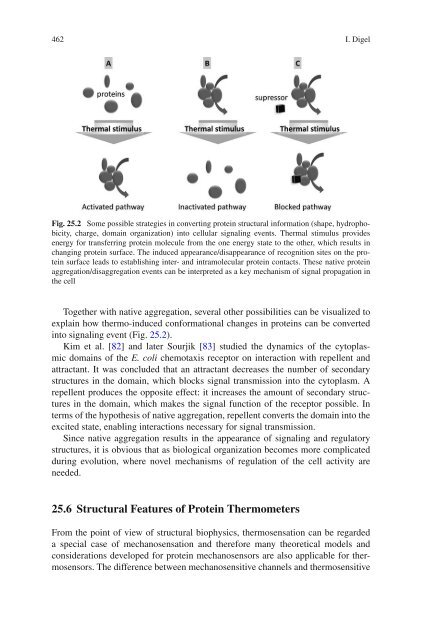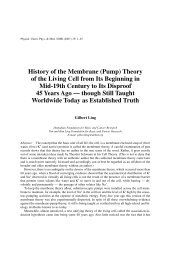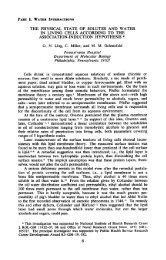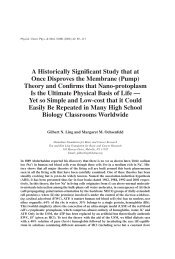Primary Thermosensory Events in Cells - Springer
Primary Thermosensory Events in Cells - Springer
Primary Thermosensory Events in Cells - Springer
You also want an ePaper? Increase the reach of your titles
YUMPU automatically turns print PDFs into web optimized ePapers that Google loves.
462 I. Digel<br />
Fig. 25.2 Some possible strategies <strong>in</strong> convert<strong>in</strong>g prote<strong>in</strong> structural <strong>in</strong>formation (shape, hydrophobicity,<br />
charge, doma<strong>in</strong> organization) <strong>in</strong>to cellular signal<strong>in</strong>g events. Thermal stimulus provides<br />
energy for transferr<strong>in</strong>g prote<strong>in</strong> molecule from the one energy state to the other, which results <strong>in</strong><br />
chang<strong>in</strong>g prote<strong>in</strong> surface. The <strong>in</strong>duced appearance/disappearance of recognition sites on the prote<strong>in</strong><br />
surface leads to establish<strong>in</strong>g <strong>in</strong>ter- and <strong>in</strong>tramolecular prote<strong>in</strong> contacts. These native prote<strong>in</strong><br />
aggregation/disaggregation events can be <strong>in</strong>terpreted as a key mechanism of signal propagation <strong>in</strong><br />
the cell<br />
Together with native aggregation, several other possibilities can be visualized to<br />
expla<strong>in</strong> how thermo-<strong>in</strong>duced conformational changes <strong>in</strong> prote<strong>in</strong>s can be converted<br />
<strong>in</strong>to signal<strong>in</strong>g event (Fig. 25.2).<br />
Kim et al. [82] and later Sourjik [83] studied the dynamics of the cytoplasmic<br />
doma<strong>in</strong>s of the E. coli chemotaxis receptor on <strong>in</strong>teraction with repellent and<br />
attractant. It was concluded that an attractant decreases the number of secondary<br />
structures <strong>in</strong> the doma<strong>in</strong>, which blocks signal transmission <strong>in</strong>to the cytoplasm. A<br />
repellent produces the opposite effect: it <strong>in</strong>creases the amount of secondary structures<br />
<strong>in</strong> the doma<strong>in</strong>, which makes the signal function of the receptor possible. In<br />
terms of the hypothesis of native aggregation, repellent converts the doma<strong>in</strong> <strong>in</strong>to the<br />
excited state, enabl<strong>in</strong>g <strong>in</strong>teractions necessary for signal transmission.<br />
S<strong>in</strong>ce native aggregation results <strong>in</strong> the appearance of signal<strong>in</strong>g and regulatory<br />
structures, it is obvious that as biological organization becomes more complicated<br />
dur<strong>in</strong>g evolution, where novel mechanisms of regulation of the cell activity are<br />
needed.<br />
25.6 Structural Features of Prote<strong>in</strong> Thermometers<br />
From the po<strong>in</strong>t of view of structural biophysics, thermosensation can be regarded<br />
a special case of mechanosensation and therefore many theoretical models and<br />
considerations developed for prote<strong>in</strong> mechanosensors are also applicable for thermosensors.<br />
The difference between mechanosensitive channels and thermosensitive







